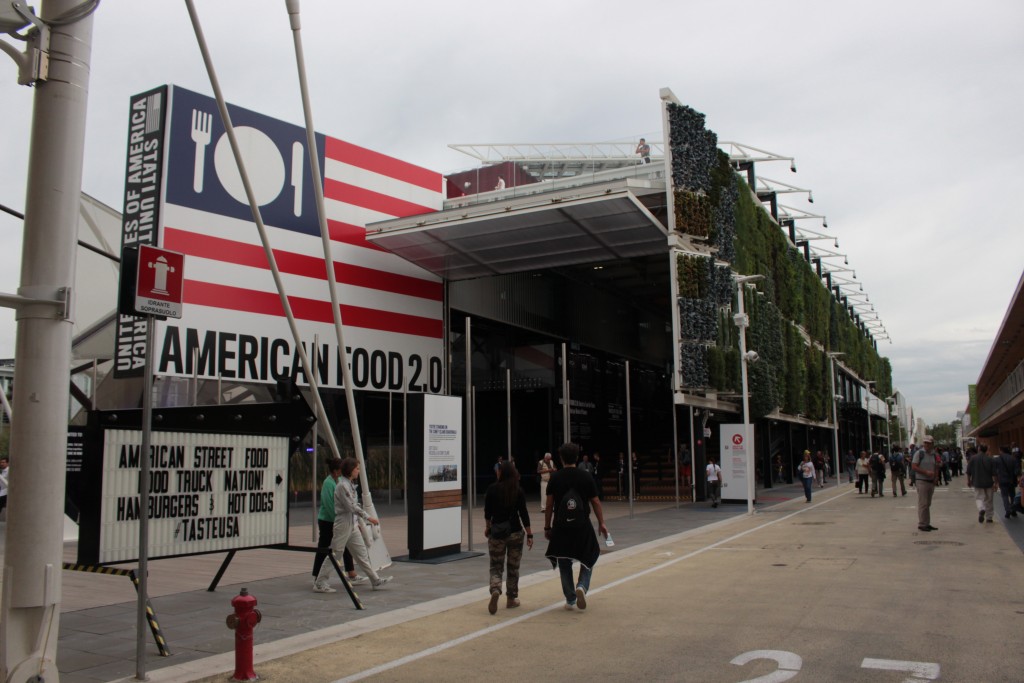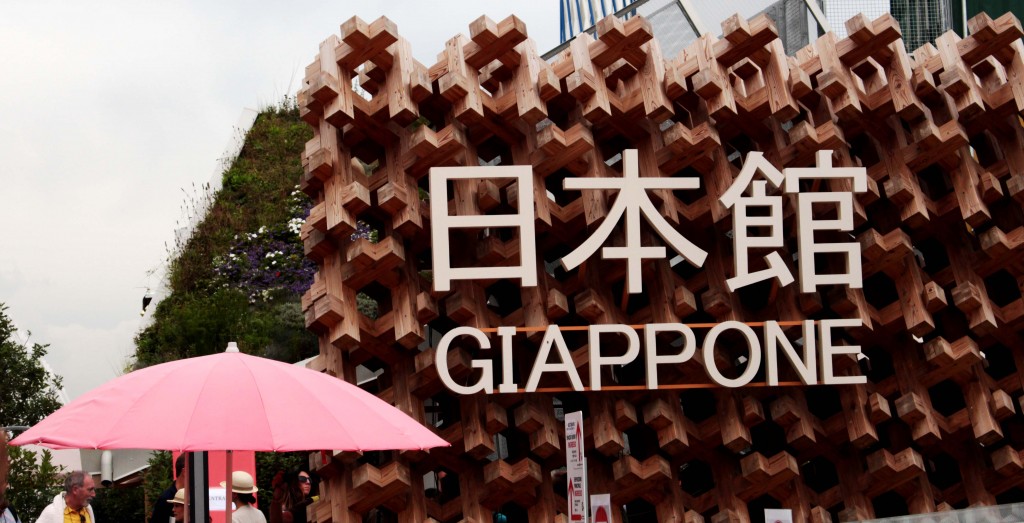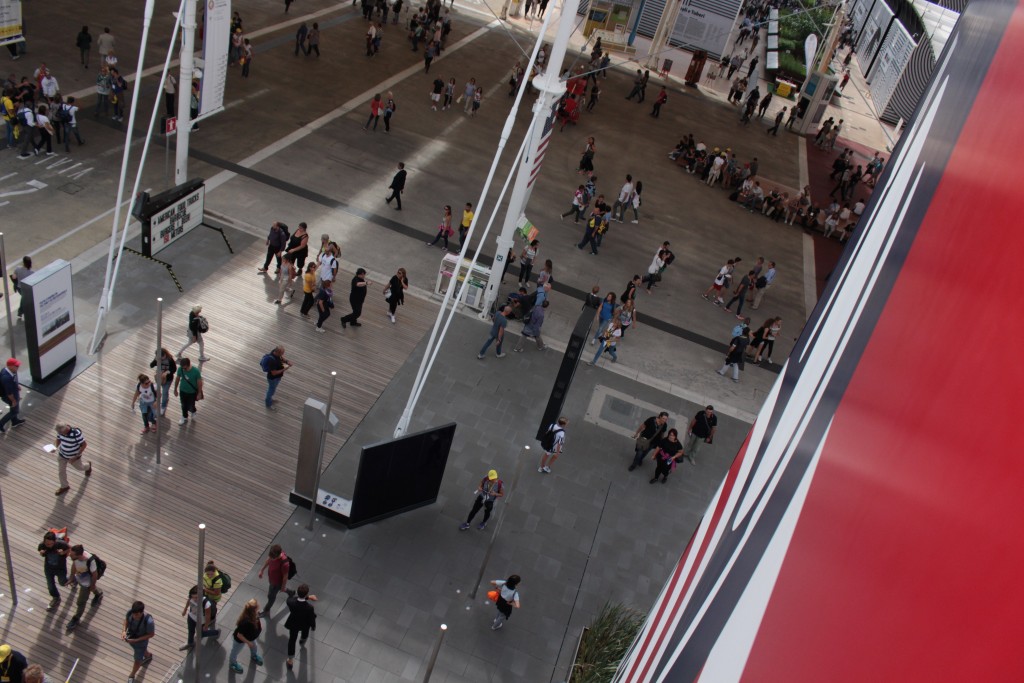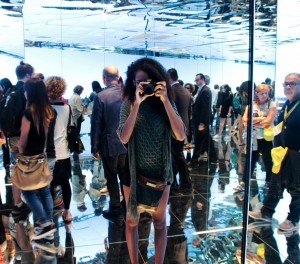
The second day in Milano included a full day excursion to the Milan Expo. Happening every five years, the expo is an event where all countries come together in one area to share their culture with the world. This year’s theme was “Feeding the Planet, Energy for Life”. In other words, every pavilion for each designated country served food from their culture in an effort to educate the masses about their traditional meals.
We departed from our hotel at 8:20 am, once again groggy and confused. The train ride was quiet and uneventful as we traveled from Dateo Station to the expo. Since we were a large group of students, some pavilions with the longest wait times granted us a free pass to skip the queues.

Photo by Michaela Delasanta
Our first appointment was with the Japanese pavilion. With a façade constructed of traditional Japanese wooden joinery, this pavilion had an average waiting time of two and a half hours. Luckily, we were able to break up into two groups and skip the wait. Once we entered the building, it was obvious why the queue was so long; each segment was increasingly interactive, culminating in the end with a ‘future restaurant’. This ‘future restaurant’ had everything that a typical Japanese restaurant would have, including a wait staff who seated us, tables where we sat, and chopsticks at each seat. The area even smelled as if dumplings were being cooked for us. The only item the restaurant was missing was the actual food, which was replaced by pictures of dumplings, meats, and fish displayed on TV screens in the tables. The fake food was a bit disappointing, since the entire experience alluded to us being fed in the end, only to be left with a empty stomachs.
We left the Japanese pavilion and headed to our next appointment at the Swiss pavilion. This building was a highly conceptual experiment dealing with the morals of each visitor. There were four towers holding four different Swiss products: water, coffee, salt, and apples. These items were free to take, with one caveat: once the resources ran out, they weren’t replenished until a specified date, when they would lower the floors in the towers to expose more products. Our tour happened to be on the last day before they lowered the floor, so the only resources left for us were salt and coffee. The architect of the pavilion showed us around and went over the concept of the building. He even took us underneath the lowering floor to see how the mechanisms worked. Conceptually, this pavilion was one of my favorites.

Photo by Michaela Delasanta
Next, we saw the USA pavilion. We had already had a lecture by the architect, Cornell alum Jim Biber, who had come to the Palazzo to discuss his design concept. The pavilion was designed to have virtually no queues; visitors can walk straight through the building while looking at the displayed exhibits. The façade was made of a vertical garden that moved depending on what ventilation was needed in the space. The pavilion also had the highest lookout point in the whole pavilion, second only to Russia. Students who volunteered to give tours of the pavilion met us when we walked up the boardwalk taken straight from Coney Island. Our tour guide was named Hunter; he was there to answer any questions we may have had about the design of the pavilion. He also took us through the video exhibit below the boardwalk that showcased short movies about American food. The videos were titled Tradition Transformed, BBQ, On the Go; Hurry, Hungry, Healthy, Thanksgiving, Farm to Table, Artisans, and The Next Bite; Feeding the Future. Each movie was completely accurate in displaying how Americans viewed food today. It was like looking at a little bit of home.

Photo by Michaela Delasanta

Photo by Michaela Delasanta
After seeing American Food 2.0, we took a tour of the Italian pavilion. We had Nemesi, the firm that designed this pavilion, come to studio to talk about their design, also. We walked around the building, looking out at the whole expo through the windows and branching façade structure. The best part of this pavilion was the series of mirrored rooms that showed projections of Italian landscapes. These effects were highly entertaining, as seen in the pictures above.
When we were finished with our appointments, the professors let us free to visit whatever pavilion we wanted to. Since it was my birthday, I decided to treat myself and eat as much food as possible while I was there. Here is the list of everything I was able to eat:
- A brisket sandwich from the American Food Truck Nation
- Sushi from the Japan pavilion
- A sweet pumpkin dessert from the Morocco pavilion
- A churro-like dessert from the Israel pavilion
- A torrone dessert with pistachios from the Israel pavilion
- Ramen from the oriental food stands
- Chocolate from the chocolate cluster
- Coffee from the coffee cluster
- Sushi (part 2)
- A Crêpe from the French pavilion
Lastly, one of my personal favorite pavilions included the Brazil pavilion, where visitors are able to walk on giant nets that penetrated the structural frame of the building. I also enjoyed the Austrian pavilion, which was a highly controlled forest, maintained by large mechanical fans that misted moisture around the site.
— Michaela
